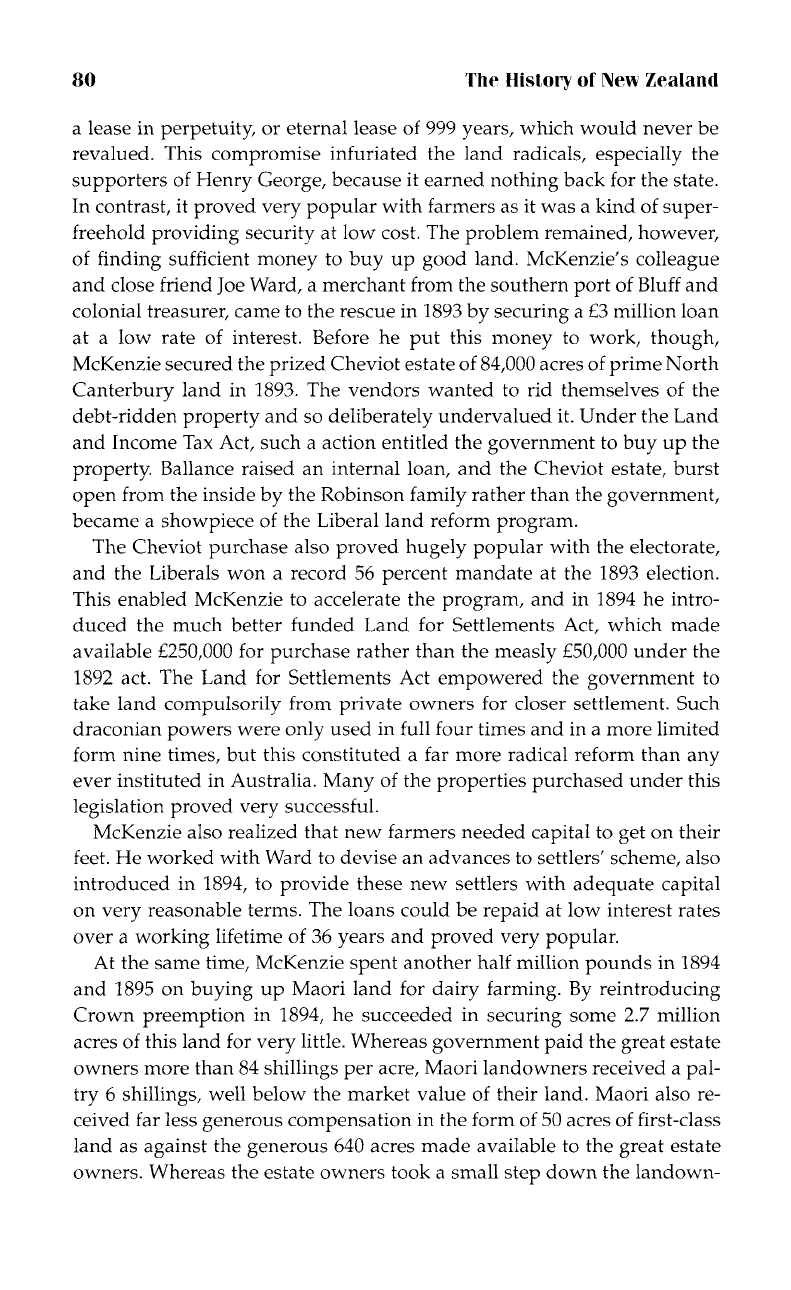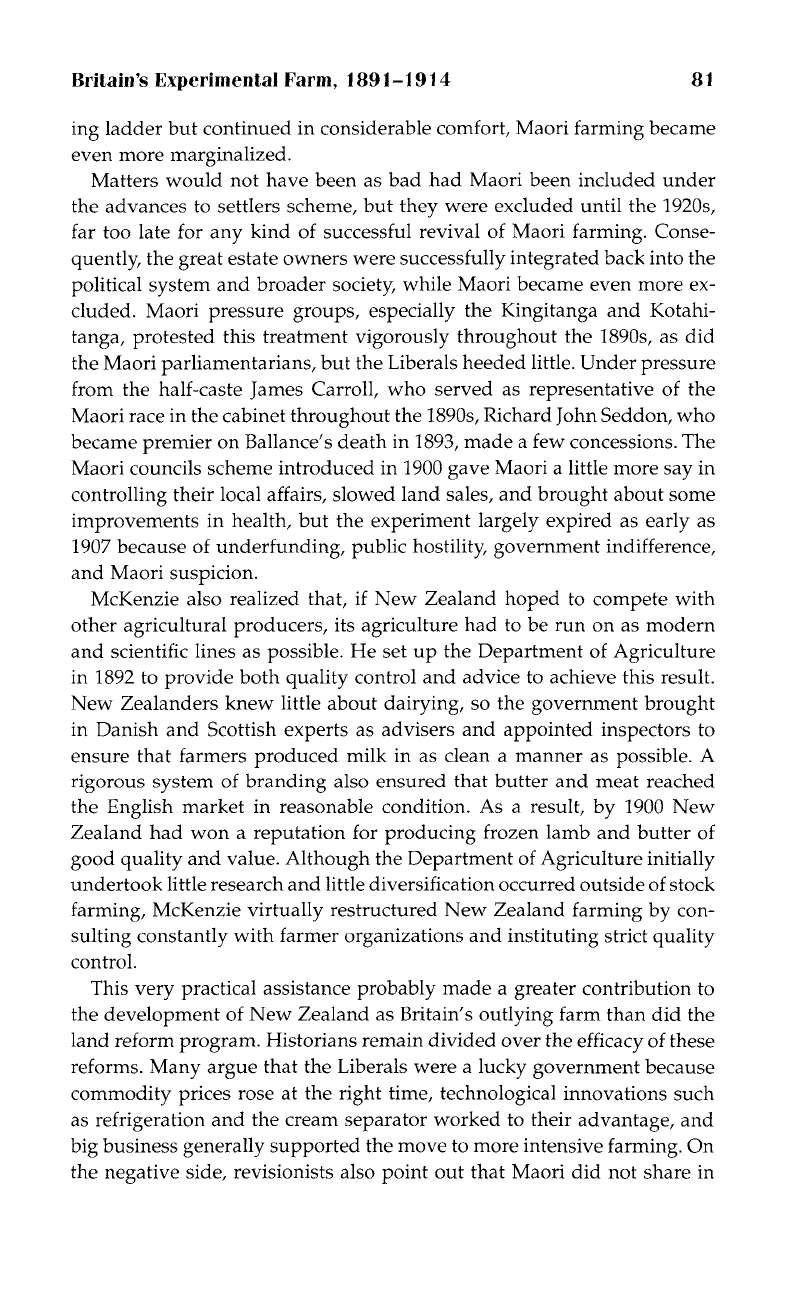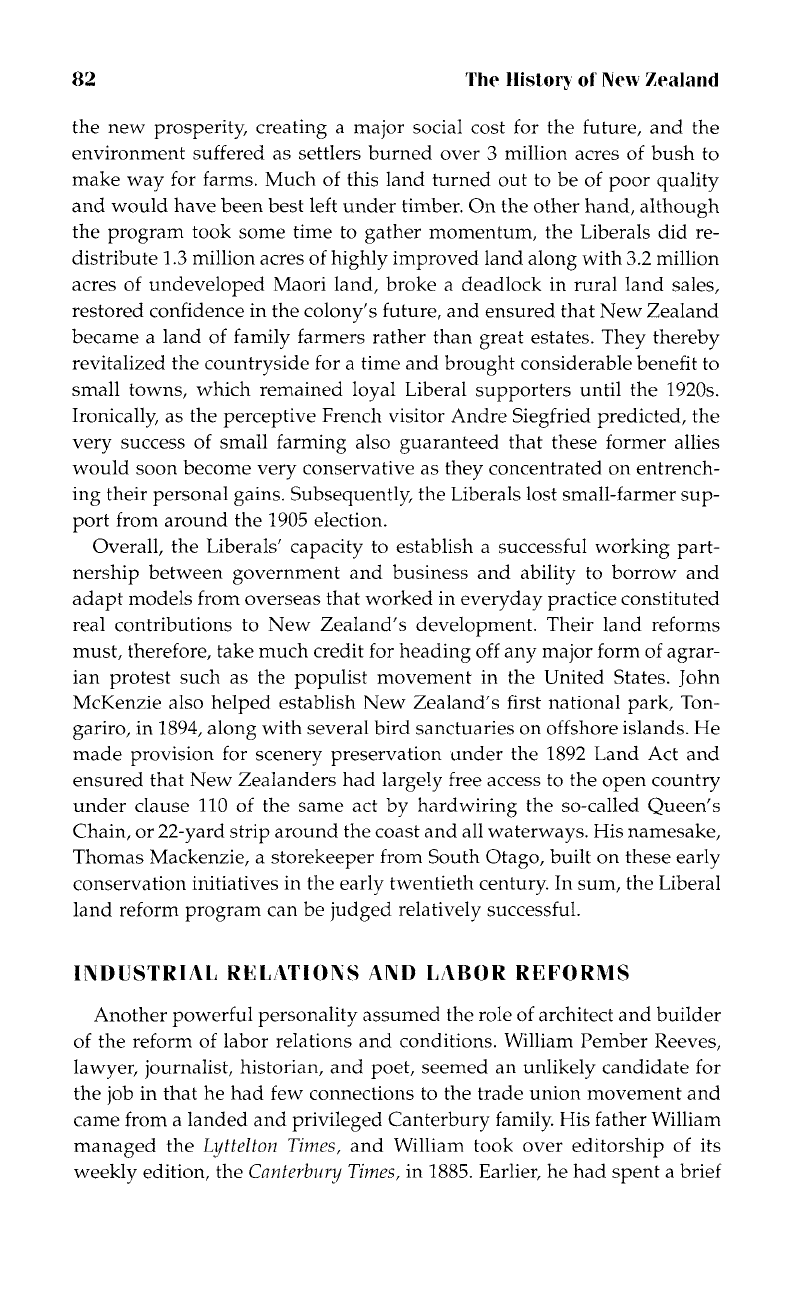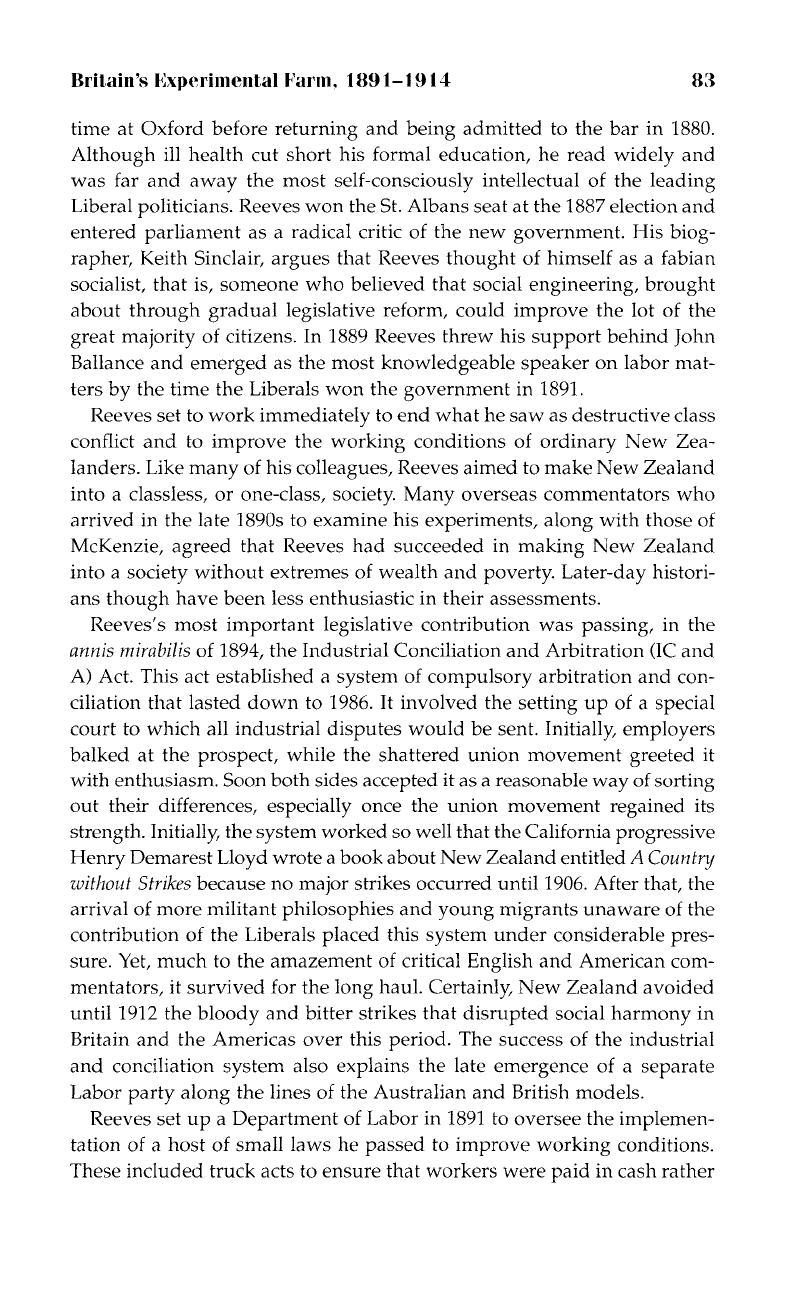Brooking T. The History of New Zealand
Подождите немного. Документ загружается.


74
The History of New Zealand
1884.
He had no more success than the Kotahitanga in actually meeting
with the monarch, but caused considerable embarrassment to the colonial
government nevertheless.
Te Kooti continued to develop his Ringatu community in the remote
Urewera ranges. Maori farming, especially amongst the wealthier Ngati
Porou iwi of the east coast, began to slowly recover. Despite the alarmingly
high rates of infant mortality (about one in three Maori children failed to
make it through the first year of life, about the same as the shocking
statistics for back-country Mexico at this time), the birthrate lifted and
population numbers began to increase. Maori may have achieved few
tangible gains, but they weathered their worst years with dignity and
patience, which helped produce more tangible advances from the 1890s.
THE LONG DEPRESSION OF 1879-1896
The boom years of the 1870s ended rather abruptly in 1879 when the
City of Glasgow Bank collapsed. This institution backed the New Zealand
and Australian Land Company, so investment in the colony dried up fast.
Indeed, British investors tended to withdraw their money out of New
Zealand in the 1880s and redirected it to the more fashionable Palatinate
region (Argentina and Uruguay). Initially, this removal of capital hit the
South Island worst, with Auckland surviving thanks to the ongoing Mel-
bourne building boom sustained by Melbourne's elevation into one of the
great cities of the late nineteenth century The region's kauri forest contin-
ued to supply the builders of "marvelous Melbourne" with excellent tim-
ber, and unemployment did not become obvious until this bubble burst
in 1885.
From this time, the whole of the New Zealand economy remained de-
pressed until around 1896. The massive migration inflows of the 1870s
turned into a steady outflow to Australia; bankruptcies increased; many
small farmers clung to mere subsistence levels; and unemployment rose
to at least 10 percent of the workforce. The new frozen meat industry,
promoted by the New Zealand and Australian Land Company, failed to
produce much beneficial impact until the
1890s,
except for the great estate
owners who built the first freezing works. Yet this industry, along with
dairying, which really only took off from the late 1890s as New Zealand
farmers learned how to run dairy cattle rather than sheep, would com-
pletely change New Zealand's economic direction in the late nineteenth
and early twentieth centuries. Several generations of historians, starting
with Guy Scholefield in 1909, have emphasized the huge importance of
the technological innovation of refrigeration in confirming New Zealand's

Boom and Bust,
1870-1890
75
role as Britain's far-flung grassland farm. Recently, James Belich has caught
the public imagination by referring to this development as "recoloniza-
tion," but his racy phrase merely supports the conclusions of many other
scholars.
In contrast to the consensus over how refrigeration made New Zealand
much more dependent upon the London market and three basic export
staples (frozen, fatty lamb; yellow butter; and wool of often indifferent
quality), historians have wasted much ink arguing about whether 1879 to
1896 constituted a long depression. Suffice to say that although we do not
know exactly how the downturn in prices impacted upon such modern
measures as gross domestic product, contemporaries felt that the New
Zealand dream, promised in such rosy fashion by the borrowing of the
1870s, seemed to be disappearing fast. We cannot calculate the exact level
of unemployment either, but it clearly was the worst in the colony's short
history. Several of Auckland's merchant princes went bankrupt in spec-
tacular fashion, along with some heavily indebted sheep farmers who had
purchased land at highly inflated prices during the 1870s. Confidence
dropped to an all-time low. Government policies of retrenching on spend-
ing did little to help ease the sense that the colony had apparently lost all
sense of direction. Talk of some kind of pension system by Premier Harry
Atkinson in
1882,
experiments with leasehold tenures by the supposedly
conservative government of John Hall and William Rolleston, and easier
terms for buying and leasing land introduced by John Ballance in 1885
and
1886
did little to restore confidence. New Zealand still constituted the
third biggest economy in Australasia after New South Wales and Victoria,
but its appeal to both investors and immigrants waned. Even a change of
government in 1891, which saw the reforming Liberals come to power,
did not lift the gloom completely because prices for frozen lamb, butter,
and wool did not recover until 1896.
British consumers had to learn that frozen lamb could be more palatable
than canned beef from Argentina and that cheap New Zealand butter
represented better value than its Danish or Victorian counterpart. The
rising standard of living of the English working class also had to come to
New Zealand's rescue because workers, and not the well-heeled gentry
and middle classes, provided the market for these rather unappetizing-
looking food products. New Zealand entrepreneurs and financiers had
originally imagined that they would sell at the top, luxury end of the
market. Instead the bottom end saved the day.
Coincidentally,
falling ship-
ping costs helped overcome the problem of exporting over such vast
distances.
Before these developments rescued the struggling economy, however,

76
The History of New Zealand
some entrepreneurs attempted to pursue a different path by trying to
develop textile manufacturing. New Zealand could still produce cheap
wool, so visionaries such as the Jewish Bendix Hallenstein and the Scots
John Ross, Robert Glendining, and John Roberts set up large mills in the
1880s, especially in or near Dunedin. Unfortunately, this effort to diversify
New Zealand's dangerously narrow export base did nor succeed because
both Australian and American politicians pursued a policy of industrial-
ization behind hefty tariff walls at this time. A modest tariff instituted in
1888 could not offset this disadvantage, and the textile industry floun-
dered thereafter. By the early 1900s New Zealand was once more export-
ing most of its wool raw, only to buy it back from Britain as finished
garments.
A major protest against so-called sweating between 1888 and 1890 also
undermined this rather desperate attempt at breaking colonial depen-
dence upon Britain (whereas only about 50 percent of New Zealand's
exports went to Britain in
1870,
as against 46 percent to Australia; by 1900
New Zealand exported over 80 percent of its produce to Britain as against
14 percent to Australia). The Reverend Rutherford Waddell, an evangelical
Presbyterian minister from Northern Ireland, delivered a very influential
sermon on the "sin of cheapness" in late 1888. The local newspaper, the
Otago Daily Times, investigated his complaints. The newspaper found that
women and boys were working very long hours (around 72-hour weeks)
for a pittance. A royal commission reported in 1890 that it could find few
definite cases of outright sweating as in Britain, but the New Zealand
public remained outraged and applauded the support given by manufac-
turers such as Bendix Hallenstein to the establishment of a Tailoresses'
Union under the leadership of Harriet Morison, to prevent any further
sweating. The reforming Liberal government then systematically with-
drew women and children from factories immediately after its election in
1891,
just as the United States began to build its economic power by em-
ploying hundreds of thousands of recently arrived female immigrants in
its factories. Skilled male laborers also worked with the new Liberal gov-
ernment to keep women out of their traditionally male workplace. New
Zealand thereby gained little advantage from the so called second indus-
trial revolution, which the United States utilized to become the greatest
economic power on Earth. So New Zealand followed a different path
to modernity and higher living standards than most other places by in-
dustrializing its agriculture rather than by pursuing the development of
manufacturing.

6
Britain's Experimental
Farm, 1891-1914
THE 1890 ELECTION AND CREATION OF THE
SOCIAL LABORATORY
The economic depression of the 1880s raised awareness among the elec-
torate that supposedly Old World evils such as poverty, juvenile delin-
quency, and exploitation of labor had found their way to New Zealand.
A large majority of voters also seemed alarmed that many of the evils of
industrialization and urbanization were now appearing in a colony estab-
lished expressly to escape the problems of dirty factories and sprawling,
dangerous, and unsanitary cities. W. H. Oliver has described this process
as the "loss of colonial innocence." Any party that appeared to offer so-
lutions to such problems and seemed to have a semblance of a plan as to
how New Zealand might be put back on the tracks had a strong chance
of winning the election held in December
1890.
The introduction of uni-
versal manhood suffrage in 1889 also helped create a mood conducive to
reform.
The Liberals, under the leadership of the northern Irishman and
Wanganui-based journalist John Ballance, constituted New Zealand's first
modern political party. It emerged slowly from 1889 as a coalition of
skilled workingmen, newly organized unions of such unskilled workers

78
The History of
New
Zealand
as coal miners and wharf laborers, and middle-class radicals. The un-
skilled organized themselves into Seamen's Wharf Laborers' and Coal
Miners' unions in 1889 and then joined forces in an umbrella organization
known as the Maritime Council in October 1889. This organization soon
became embroiled in large strike from August
1890,
essentially to support
its Australian equivalent. The strike drew the unskilled unions closer to
both the skilled unions and the middle-class radicals, but alienated po-
tential small-farmer supporters. Consequently, it seemed unclear whether
Ballance had enough support to win the government. Policies advocated
by the Liberals and Harry Atkinson's government also seemed pretty
similar, except that the Liberals promised to replace the existing property
tax, which penalized improvements such as farm buildings, with a pure
land tax.
As a younger man Ballance had talked a lot about J. S. Mill's idea of
slowly nationalizing the land and had shown interest in Henry George's
idea that a single land tax would break land monopoly more effectively
than any other measure. But Ballance did not express anything so radi-
cal during the campaign and made it clear that the land tax would be
accompanied by a progressive income tax. His caution seemed to
back-
fire when a separate Labor Party emerged in Dunedin, so that humble
working-class men such as brass finishers and boot clickers (the persons
who attach the top part of a shoe to the sole) could stand for parliament
for the first time.
Much to the surprise of the conservative press, Ballance won narrowly
and soon gathered the support of five Labor members of parliament
(MPs).
Atkinson panicked and stacked the Legislative Council with his
own supporters to prevent the passage of any radical legislation. This
action infuriated the seven independent small-farmer MPs, and they too
threw in their lot with Ballance. So the Liberals emerged as an unlikely
coalition of both skilled and unskilled workingmen on the
left;
small-town
businessmen, journalists, and lawyers in the middle; and small farmers
on the right. In short, the Liberals constituted New Zealand's first broad-
based democratic party. The Liberals also soon absorbed the Labor Party,
so that a separate Labor Party like those in the Australian states did not
reappear until much later, only becoming a permanent fixture on the po-
litical landscape in 1916.
By March 1891 the Liberals held a large majority of 50 out of 74 seats
in the lower house and clearly had the mandate to initiate reforms. They
set about their task with enthusiasm, concentrating their efforts on attack-
ing land monopoly and overhauling the industrial relations system.

Britain's Experimental Farm, 1891-1914
79
LAND REFORM AND MODERNIZATION OF
AGRICULTURE
Ballance introduced his promised Land and Income Tax Act and im-
mediately won favor with small farmers by exempting anyone who owned
land valued at less than £500 from paying the land tax. He also set about
reducing the power of the Legislative Council by appealing to the highest
court in the empire, the Privy Council in London. Before Ballance died of
cancer in
1893,
the Privy Council upheld his claim that Atkinson had acted
unfairly in stacking the upper house and granted Ballance the right to
appoint councilors supportive of his government. Men from such humble
backgrounds as boiler-making and printing thereby served on this body
for the first time. Once he had thawed the legislative body dubbed "the
freezing chamber" by his colleagues, Ballance handed control of the land
reform program over to the six foot four inch,
18
stone Scottish highlander,
John McKenzie. This big, angry, but realistic man became both architect
and builder of the land reform program.
McKenzie had witnessed the highland clearances as small boy. He ar-
rived in New Zealand in 1860 determined that the unequal patterns of
land ownership that forced hard-working crofters from their homes should
not be allowed to develop in New Zealand. When it became clear that the
problem of land monopoly had found its way to the new colony, he de-
cided to enter politics to rid his new country of what he viewed as a curse.
He entered the House of Representatives in 1881; and despite a rather
undistinguished career as a backbencher, he nevertheless won a reputa-
tion as an expert on land settlement. During the 1880s McKenzie also
became more pragmatic and learned the important lesson that closer set-
tlement could work only if it provided a viable living for settlers. Imme-
diately, this pragmatism set him at cross-purpose with many urban-based
radicals, who held a more romantic view of New Zealand as nation of
superpeasants running tiny farms. McKenzie, in contrast, wanted middle-
sized farms of 340 to 640 acres that would earn comfortable livings for
farmers and their families. He also hoped to place many families on
smaller but properly managed dairy farms. First, though, he had to per-
suade big landowning families and companies to sell. This meant that he
would have to pay the market rate, or better, making reform costly.
In 1891 McKenzie tried to introduce a lease to be revalued every 50
years,
only to have it rejected by the upper house. After a tour of the
North Island in late 1891, farmers who wanted the freehold persuaded
him to change tactics. In
1892
he responded to this demand by introducing

80 The History of New Zealand
a lease in perpetuity, or eternal lease of 999 years, which would never be
revalued. This compromise infuriated the land radicals, especially the
supporters of Henry George, because it earned nothing back for the state.
In contrast, it proved very popular with farmers as it was a kind of super-
freehold providing security at low cost. The problem remained, however,
of finding sufficient money to buy up good land.
McKenzie's
colleague
and close friend Joe Ward, a merchant from the southern port of Bluff and
colonial treasurer, came to the rescue in
1893
by securing a £3 million loan
at a low rate of interest. Before he put this money to work, though,
McKenzie secured the prized Cheviot estate of 84,000 acres of prime North
Canterbury land in
1893.
The vendors wanted to rid themselves of the
debt-ridden property and so deliberately undervalued it. Under the Land
and Income Tax Act, such a action entitled the government to buy up the
property. Ballance raised an internal loan, and the Cheviot estate, burst
open from the inside by the Robinson family rather than the government,
became a showpiece of the Liberal land reform program.
The Cheviot purchase also proved hugely popular with the electorate,
and the Liberals won a record 56 percent mandate at the 1893 election.
This enabled McKenzie to accelerate the program, and in 1894 he intro-
duced the much better funded Land for Settlements Act, which made
available £250,000 for purchase rather than the measly £50,000 under the
1892 act. The Land for Settlements Act empowered the government to
take land compulsorily from private owners for closer settlement. Such
draconian powers were only used in full four times and in a more limited
form nine times, but this constituted a far more radical reform than any
ever instituted in Australia. Many of the properties purchased under this
legislation proved very successful.
McKenzie also realized that new farmers needed capital to get on their
feet. He worked with Ward to devise an advances to settlers' scheme, also
introduced in 1894, to provide these new settlers with adequate capital
on very reasonable terms. The loans could be repaid at low interest rates
over a working lifetime of 36 years and proved very popular.
At the same time, McKenzie spent another half million pounds in 1894
and 1895 on buying up Maori land for dairy farming. By
reintroducing
Crown preemption in 1894, he succeeded in securing some 2.7 million
acres of this land for very little. Whereas government paid the great estate
owners more than 84 shillings per acre, Maori landowners received a pal-
try 6 shillings, well below the market value of their land. Maori also re-
ceived far less generous compensation in the form of 50 acres of first-class
land as against the generous 640 acres made available to the great estate
owners. Whereas the estate owners took a small step down the landown-

Britain's Experimental Farm, 1891-1914 81
ing ladder but continued in considerable comfort, Maori farming became
even more marginalized.
Matters would not have been as bad had Maori been included under
the advances to settlers scheme, but they were excluded until the 1920s,
far too late for any kind of successful revival of Maori farming. Conse-
quently, the great estate owners were successfully integrated back into the
political system and broader society, while Maori became even more ex-
cluded. Maori pressure groups, especially the Kingitanga and Kotahi-
tanga, protested this treatment vigorously throughout the 1890s, as did
the Maori parliamentarians, but the Liberals heeded little. Under pressure
from the half-caste James Carroll, who served as representative of the
Maori race in the cabinet throughout the
1890s,
Richard John Seddon, who
became premier on Ballance's death in 1893, made a few concessions. The
Maori councils scheme introduced in 1900 gave Maori a little more say in
controlling their local affairs, slowed land sales, and brought about some
improvements in health, but the experiment largely expired as early as
1907 because of underfunding, public hostility, government indifference,
and Maori suspicion.
McKenzie also realized that, if New Zealand hoped to compete with
other agricultural producers, its agriculture had to be run on as modern
and scientific lines as possible. He set up the Department of Agriculture
in 1892 to provide both quality control and advice to achieve this result.
New Zealanders knew little about dairying, so the government brought
in Danish and Scottish experts as advisers and appointed inspectors to
ensure that farmers produced milk in as clean a manner as possible. A
rigorous system of branding also ensured that butter and meat reached
the English market in reasonable condition. As a result, by 1900 New
Zealand had won a reputation for producing frozen lamb and butter of
good quality and value. Although the Department of Agriculture initially
undertook little research and little diversification occurred outside of stock
farming, McKenzie virtually restructured New Zealand farming by con-
sulting constantly with farmer organizations and instituting strict quality
control.
This very practical assistance probably made a greater contribution to
the development of New Zealand as Britain's outlying farm than did the
land reform program. Historians remain divided over the efficacy of these
reforms. Many argue that the Liberals were a lucky government because
commodity prices rose at the right time, technological innovations such
as refrigeration and the cream separator worked to their advantage, and
big business generally supported the move to more intensive farming. On
the negative side, revisionists also point out that Maori did not share in

82
The
History
of New Zealand
the new prosperity, creating a major social cost for the future, and the
environment suffered as settlers burned over 3 million acres of bush to
make way for farms. Much of this land turned out to be of poor quality
and would have been best left under timber. On the other hand, although
the program took some time to gather momentum, the Liberals did re-
distribute 1.3 million acres of highly improved land along with 3.2 million
acres of undeveloped Maori land, broke a deadlock in rural land sales,
restored confidence in the colony's future, and ensured that New Zealand
became a land of family farmers rather than great estates. They thereby
revitalized the countryside for a time and brought considerable benefit to
small towns, which remained loyal Liberal supporters until the 1920s.
Ironically, as the perceptive French visitor Andre Siegfried predicted, the
very success of small farming also guaranteed that these former allies
would soon become very conservative as they concentrated on entrench-
ing their personal gains. Subsequently, the Liberals lost small-farmer sup-
port from around the 1905 election.
Overall, the Liberals' capacity to establish a successful working part-
nership between government and business and ability to borrow and
adapt models from overseas that worked in everyday practice constituted
real contributions to New Zealand's development. Their land reforms
must, therefore, take much credit for heading off any major form of agrar-
ian protest such as the populist movement in the United States. John
McKenzie also helped establish New Zealand's first national park, Ton-
gariro, in 1894, along with several bird sanctuaries on offshore islands. He
made provision for scenery preservation under the 1892 Land Act and
ensured that New Zealanders had largely free access to the open country
under clause 110 of the same act by hardwiring the so-called Queen's
Chain, or 22-yard strip around the coast and all waterways. His namesake,
Thomas Mackenzie, a storekeeper from South Otago, built on these early
conservation initiatives in the early twentieth century. In sum, the Liberal
land reform program can be judged relatively successful.
INDUSTRIAL RELATIONS AND LABOR REFORMS
Another powerful personality assumed the role of architect and builder
of the reform of labor relations and conditions. William
Pember
Reeves,
lawyer, journalist, historian, and poet, seemed an unlikely candidate for
the job in that he had few connections to the trade union movement and
came from a landed and privileged Canterbury family. His father William
managed the Lyttelton Times, and William took over editorship of its
weekly edition, the Canterbury Times, in 1885. Earlier, he had spent a brief

Britain's Experimental Farm,
1891-1914
83
time at Oxford before returning and being admitted to the bar in
1880.
Although ill health cut short his formal education, he read widely and
was far and away the most self-consciously intellectual of the leading
Liberal politicians. Reeves won the St. Albans seat at the 1887 election and
entered parliament as a radical critic of the new government. His biog-
rapher, Keith Sinclair, argues that Reeves thought of himself as a fabian
socialist, that is, someone who believed that social engineering, brought
about through gradual legislative reform, could improve the lot of the
great majority of citizens. In
1889
Reeves threw his support behind John
Ballance and emerged as the most knowledgeable speaker on labor mat-
ters by the time the Liberals won the government in 1891.
Reeves set to work immediately to end what he saw as destructive class
conflict and to improve the working conditions of ordinary New Zea-
landers. Like many of his colleagues, Reeves aimed to make New Zealand
into a classless, or one-class, society. Many overseas commentators who
arrived in the late
1890s
to examine his experiments, along with those of
McKenzie, agreed that Reeves had succeeded in making New Zealand
into a society without extremes of wealth and poverty. Later-day histori-
ans though have been less enthusiastic in their assessments.
Reeves's most important legislative contribution was passing, in the
annis mirabilis of 1894, the Industrial Conciliation and Arbitration
(IC
and
A) Act. This act established a system of compulsory arbitration and con-
ciliation that lasted down to 1986. It involved the setting up of a special
court to which all industrial disputes would be sent. Initially, employers
balked at the prospect, while the shattered union movement greeted it
with enthusiasm. Soon both sides accepted it as a reasonable way of sorting
out their differences, especially once the union movement regained its
strength. Initially, the system worked so well that the California progressive
Henry Demarest Lloyd wrote a book about New Zealand entitled A Country
without Strikes because no major strikes occurred until 1906. After that, the
arrival of more militant philosophies and young migrants unaware of the
contribution of the Liberals placed this system under considerable pres-
sure.
Yet, much to the amazement of critical English and American com-
mentators, it survived for the long haul. Certainly, New Zealand avoided
until 1912 the bloody and bitter strikes that disrupted social harmony in
Britain and the Americas over this period. The success of the industrial
and conciliation system also explains the late emergence of a separate
Labor party along the lines of the Australian and British models.
Reeves set up a Department of Labor in 1891 to oversee the implemen-
tation of a host of small laws he passed to improve working conditions.
These
included
truck acts to ensure that workers were paid in cash rather
